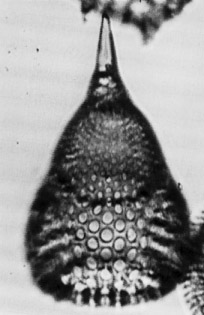 Podocyrtis
(Podocyrtoges) ampla Ehrenberg
Podocyrtis
(Podocyrtoges) ampla Ehrenberg Podocyrtis
(Podocyrtoges) ampla Ehrenberg
Podocyrtis
(Podocyrtoges) ampla EhrenbergPodocyrtis(?) ampla Ehrenberg, 1873, p.248; 1875, pl.16, fig.7; Riedel and Sanfilippo, 1970, p.533, pl.12, figs.7-8
Podocyrtis (Podocyrtoges) ampla Ehrenberg, Sanfilippo and Riedel, 1992, p.14, pl.5, fig.4
Cephalis [three-lobed], subspherical, with few small pores, bearing a stout conical horn of variable length. Collar and lumbar strictures not pronounced. Thorax conical, of approximately the same length as the abdomen, with circular pores in longitudinal rows separated by ridges. Abdomen truncate-conical or subcylindrical, slightly inflated, with pores, larger than those of the thorax, usually arranged in approximate longitudinal rows without intervening ridges. Abdomen terminates in a narrow, thickened rim from which arise (in early specimens only) three small, shovel-shaped or spathulate feet (Riedel and Sanfilippo, 1970).
Length (excluding horn and feet) 240-280 µm; maximum breadth 170-205 µm (Sanfilippo and Riedel, 1970).
P. (P.) ampla differs from P. (P.) phyxis in tending toward a conical shape by reduction of the lumbar stricture, the thorax becoming conical rather than campanulate, and the abdomen becoming widest distally rather than medially. Also, late forms have ribs between the longitudinal rows of thoracic pores. It differs from P. (P.) diamesa by the relatively more voluminous abdomen with larger pores not separated by longitudinal ribs (Sanfilippo et al., 1985).
Early specimens have three small, spathulate feet, absent in later specimens, and the thorax is less pronouncedly ribbed (Sanfilippo et al., 1985).
This middle middle Eocene species is found in large numbers in the Pacific Ocean and Caribbean, and much more rarely in the Indian Ocean. It occurs in moderate abundance in the eastern Atlantic. Its evolutionary transition from Podocyrtis phyxis defines the base of the Podocyrtis ampla Zone. Its morphotypic last appearance lies within the Podocyrtis mitra Zone.
It seems that P. (P.) ampla evolved from P. (P.) diamesa by way of P. (P.) phyxis, and left no descendants. The only awkward aspect of this interpretation is the fact that a form with unribbed thorax (P. phyxis) is interposed between an ancestor and descendant with usually ribbed thorax (P. diamesa and P. ampla). This can only be explained by regarding the later occurrence of thoracic ribs as a secondary development (Sanfilippo et al., 1985).